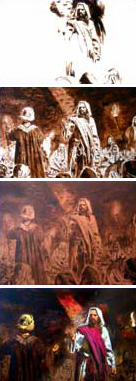Drawing Methods
I have drawn with many different medias but most recently have been working with nupastel on a Strathmore 400 series bristol 2-ply kid finish drawing paper. I use sanding blocks for various tips and a variety of stumps, paper towels, erasers, and occasionally paint brushes to achieve my results. I prefer to work from life, but having done illustration for years, I am able to use photos when necessary.
I stress to my students constantly the need to translate or interpret rather than copy or render what they are seeing. Working from life builds a foundation that is very helpful when working from photos or memory.
I use traditional procedures that have existed from the Renaissance which include measuring, gridding, and looking for angles and landmarks.
I start with the big placement, silhouette, or “gestalt” of the figure using the nupastel on its side and cover large areas with an earth tone color. This helps with gesture, composition, staging, and placement. I then use a process where I work from general “block-ins” to more specific contours and shapes.
I attempt to work on the whole drawing simultaneously never finishing one part at the expense of another part.
Working in reverse by lifting lighter tones out of the darker tones helps greatly in articulating the design of the shapes and controlling the edges of the contours.
This approach to drawing is very valuable as a bridge into painting and informs my painting in a variety of ways. I incorporate local value, light and shadow, and atmospheric perspective, as tools to indicate space and pattern but am constantly looking for ways to edit and simplify certain passages.
Though my work appears traditionally realistic, I try to use a variety of interesting abstract surface textures and mark-making.
I believe that drawing is the beginning of personal vision and one of the most efficient ways to record visual ideas. I believe it to be the basis of all the visual arts.

